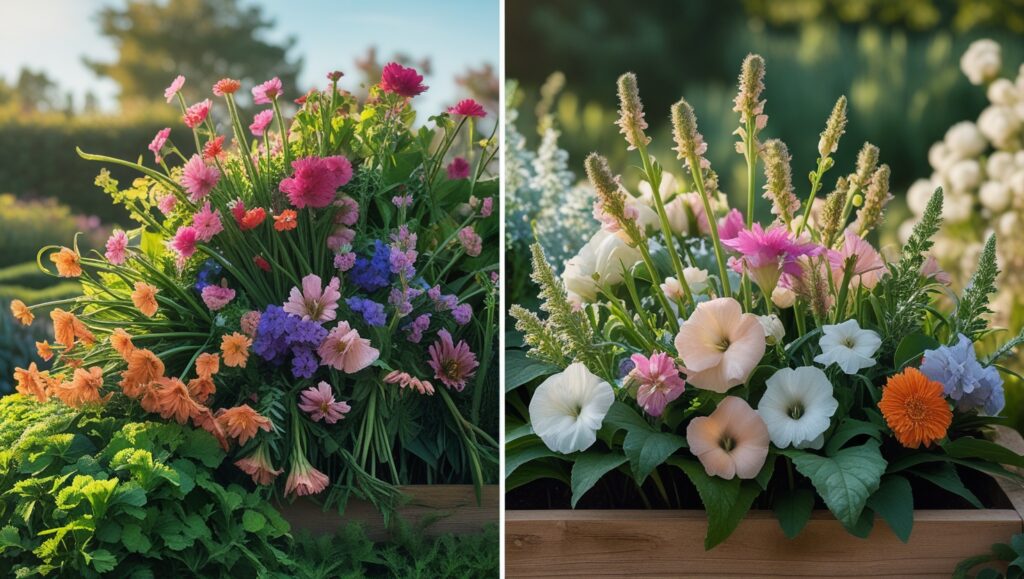
Every time I walk through my cut flower garden, I’m reminded that beauty doesn’t just happen by chance—it’s designed.
Years ago, when I first started, I planted my blooms wherever I found an empty spot, thinking nature would take care of the rest. The result? A tangled mess of colors, uneven growth, and flowers competing for sunlight. It was frustrating, but it taught me a vital truth: the best layout for cut flower beds is the foundation of a thriving garden.
A well-thought-out design can turn your space—whether it’s a sprawling backyard or a small urban plot—into a steady source of fresh, healthy blooms. And it’s not just about beauty; it’s about yield, plant health, and making your gardening time more enjoyable. In this guide, I’ll walk you through the principles and practical tips I’ve learned over the years, so you can start your flower season with confidence and a plan that works.
Understanding Cut Flower Bed Layout Basics
Why Layout Matters for Healthy Blooms and High Yield
The way you arrange your cut flower beds determines how much light, water, and nutrients each plant receives. A thoughtful layout:
- Reduces disease by improving air circulation
- Makes harvesting easier and faster
- Ensures every bloom has the sunlight it needs
- Helps you predict and plan for staggered bloom times
When I finally embraced structured layouts, I noticed a remarkable change—my stems grew straighter, colors were more vibrant, and I was harvesting more flowers than ever before.
Common Bed Shapes for Cut Flower Gardens

Your bed shape sets the stage for your garden’s look and function. Popular choices include:
- Rectangular beds – Easy to measure, plant, and maintain.
- L-shaped beds – Great for corner spaces and visual interest.
- Curved beds – Add a natural, flowing aesthetic to larger gardens.
For beginners, I recommend rectangular or straight rows—they’re straightforward and ideal for tracking your planting success.
How Bed Orientation Affects Sunlight and Growth
Sunlight is the lifeblood of your blooms. Beds oriented north to south ensure even light distribution throughout the day. If you run your beds east to west, plants on the south side may shade those behind them.
I learned this the hard way when my tallest sunflowers blocked a whole row of zinnias from getting enough light. Now, I always check the sun’s path before setting up new beds.
Planning Your Cut Flower Bed
Choosing the Right Location for Maximum Sun Exposure
Most cut flowers love 6–8 hours of direct sunlight daily. Look for a spot with minimal shade from buildings, fences, or trees. If you’re working in a smaller yard, even a sunny strip along a fence can be transformed into a productive flower bed.
Considering Soil Quality and Drainage
Healthy soil is the secret ingredient to lush blooms. Before planting, test your soil’s pH (ideally 6.0–7.0) and check drainage by soaking an area and seeing if water drains within a few hours. Standing water can suffocate roots, leading to poor growth.
I once lost an entire bed of cosmos to root rot because I didn’t address a drainage issue—lesson learned.
Deciding Bed Dimensions and Path Widths
For most home gardeners, 3–4 feet wide beds are ideal—you can reach the center without stepping on the soil, which helps keep it loose and airy. Paths should be at least 18 inches wide for comfortable movement and wheelbarrow access.
Mapping Out Your Beds Before Planting
Sketching your layout on paper—or even with stakes and string—saves time and headaches later. Mark where each flower type will go, considering bloom times, heights, and colors. It’s like setting the stage for your garden’s big performance.
Designing for Continuous Blooms
Grouping Flowers by Bloom Time

By planting flowers that bloom at different times, you’ll have a constant flow of fresh stems. For example:
| Bloom Season | Flower Examples | Notes |
|---|---|---|
| Early Spring | Tulips, Daffodils | Plant in fall for early color |
| Summer | Zinnias, Sunflowers | Thrive in heat |
| Fall | Dahlias, Chrysanthemums | Extend the season’s beauty |
Mixing Annuals, Perennials, and Biennials
A mix gives you stability and variety:
- Annuals – Quick growers like cosmos and marigolds for instant color.
- Perennials – Peonies and echinacea return year after year.
- Biennials – Sweet williams and foxgloves bloom in their second year, adding surprise elements to your garden.
Succession Planting for a Longer Harvest
This technique means planting in intervals so new flowers replace the ones you cut or that fade out. For instance, sowing a new row of zinnias every 2–3 weeks ensures fresh blooms until frost.
Tools & Supplies for Creating Perfect Cut Flower Beds
Must-Have Tools for Layout and Planting
Having the right tools makes garden design much smoother—and much more enjoyable. My essentials include:
- Measuring tape – For precise bed and path dimensions.
- Garden hoe – Ideal for marking rows and breaking up soil.
- Stakes and twine – To mark straight lines and define bed edges.
- Trowel and hand fork – For transplanting and small digging jobs.
These tools not only help create a professional-looking layout but also save you from back-breaking guesswork.
Mulching, Irrigation, and Support Structures
Mulch is your best friend for weed suppression and moisture retention. I like using shredded leaves or straw—it breaks down beautifully and enriches the soil.
For irrigation, drip systems are my go-to. They deliver water right to the roots without wetting foliage, which helps prevent disease. And don’t forget supports like flower netting or stakes—they keep your tall stems standing proud even in strong summer winds.
Common Mistakes to Avoid When Laying Out Cut Flower Beds
Overcrowding Plants

It’s tempting to pack as many flowers as possible into a bed, but overcrowding leads to poor airflow, disease, and smaller blooms. I learned this the hard way when my first bed of snapdragons turned into a tangle of mildew-covered stems. Give each plant the space it needs to thrive.
Ignoring Pathways for Access
Paths aren’t wasted space—they’re essential. Without them, harvesting becomes a gymnastics routine. Plan at least 18 inches for walking and 24 inches if you’ll use a wheelbarrow.
Planting Without Considering Bloom Times
If you don’t stagger your plantings or group flowers by bloom time, you’ll face awkward gaps in your harvest. Planning for continuous blooms keeps your garden productive from spring through fall.
Maintaining and Adjusting Your Layout Over Time
Tracking Performance Each Season
I keep a garden journal to record what worked, what didn’t, and where I could improve. Photos, planting dates, and yield notes help me refine my design each year.
Rotating Crops to Prevent Disease
Rotating where you plant certain flowers—especially those prone to soil-borne diseases like dahlias—can keep your garden healthy. Avoid replanting the same species in the exact spot for at least two years.
Expanding or Redesigning as Your Garden Grows
Your first layout doesn’t have to be your forever layout. As your confidence grows, you may want to experiment with new shapes, larger beds, or more complex planting schemes. That’s part of the joy—your garden evolves along with you.
Conclusion

Designing the best layout for cut flower beds is part art, part science, and a whole lot of heart. Every choice—from bed shape to bloom timing—has a ripple effect on your garden’s health, beauty, and productivity. I’ve learned that a thoughtful plan not only saves time and energy but also makes gardening more rewarding.
Remember, your garden doesn’t need to be perfect to bring joy. Start simple, observe how your plants respond, and adjust each season. With a little planning and care, you’ll create a space that not only fills vases but also fills your soul.
FAQs
1. What is the best layout for cut flower beds in small spaces?
In small gardens, straight rows or compact block planting works best. Focus on multi-use paths and choose plants with varied bloom times to maximize yield in limited space.
2. How wide should a cut flower bed be?
For easy access, 3–4 feet wide is ideal. This allows you to reach the center from either side without stepping on the soil, which keeps it loose and healthy.
3. Can I change my flower bed layout mid-season?
Yes, small adjustments—like adding supports or widening paths—are fine mid-season. Major redesigns are best done in the off-season to avoid disturbing plant roots.

